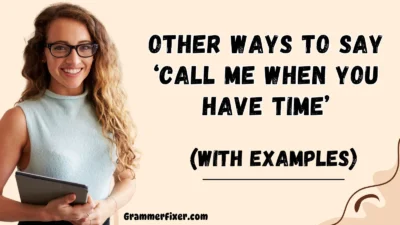When it comes to expressing warmth, openness, and encouragement, saying “please feel free” is a great start—but it’s not the only way. Whether you’re speaking to a colleague, client, friend, or customer, the words you choose can shape how your message is received. That’s why finding empathetic, thoughtful alternatives helps you sound more approachable and inclusive.
This list explores 30 powerful alternatives that reflect kindness, clarity, and professionalism—perfect for emails, messages, meetings, or everyday conversations.
What Does “Please Feel Free” Mean?
“Please feel free” is a polite and encouraging phrase used to give permission, show openness, or invite someone to take action or initiative without hesitation. It reflects a supportive attitude and communicates that the listener or reader is welcome to do something without needing formal approval.
Is It Professional/Polite to Say “Please Feel Free”?
Yes, “please feel free” is both professional and polite when used in the right tone and context. It’s ideal for business communication, especially when paired with a welcoming tone, such as:
- Please feel free to reach out if you have any questions.
- Feel free to make suggestions during the team meeting.
However, there may be times when a different expression better matches your tone, brand image, or audience, especially when you want to sound either more formal, friendly, or casual.
Advantages and Disadvantages of Saying “Please Feel Free”
Advantages:
- Conveys approachability and trustworthiness
- Encourages open communication and feedback
- Shows consideration and empathy
Disadvantages:
- May sound impersonal or repetitive when overused
- Sometimes lacks actionable clarity (e.g., what exactly should they feel free to do?)
- May not resonate in more formal or culturally nuanced settings
1. Don’t Hesitate
Meaning: Encouragement to take action without holding back.
Explanation: This phrase is a friendly and confident way to invite someone to do something—whether that’s asking questions, providing feedback, or reaching out for help. It eliminates fear of judgment.
Example Scenario:
Don’t hesitate to contact me if you need further clarification on the proposal.
Best Use: Client communication, customer support, team collaboration
Tone: Warm, professional, confident
2. You’re Welcome To
Meaning: An open invitation granting permission or access.
Explanation: This phrase reinforces a sense of hospitality and freedom of choice. It works great when you want to welcome someone’s involvement or action without pressuring them.
Example Scenario:
You’re welcome to join our brainstorming session tomorrow at 2 p.m.
Best Use: Team dynamics, collaborative environments, workshops
Tone: Friendly, inclusive, casual-professional
3. Be My Guest
Meaning: A courteous, somewhat casual way of granting permission.
Explanation: Ideal in informal or semi-formal settings, this phrase balances humor and kindness, often used in relaxed conversations while still showing respect and approachability.
Example Scenario:
Need to use the projector for your pitch? Be my guest!
Best Use: Internal team communication, relaxed meetings, friendly discussions
Tone: Light-hearted, warm, easy-going
4. Feel At Liberty
Meaning: An elegant, formal alternative granting freedom to act.
Explanation: This phrase suits formal writing and speech, often implying respectful autonomy. It gives the recipient the confidence to take action, ask questions, or make suggestions.
Example Scenario:
Please feel at liberty to suggest alternative strategies during the planning session.
Best Use: Corporate emails, professional reports, client briefs
Tone: Formal, respectful, composed
5. Don’t Feel Like You Must
Meaning: Reassures someone that they are under no obligation.
Explanation: This is useful when you want to reduce pressure and give people space, showing you understand their time or priorities. It’s especially empathetic when dealing with sensitive or optional matters.
Example Scenario:
Don’t feel like you must respond today—take your time and get back to me when convenient.
Best Use: Empathetic communication, flexible deadlines, informal updates
Tone: Supportive, gentle, understanding
6. No Need to Hesitate
Meaning: Reassurance to proceed without second-guessing or fear.
Explanation: A softer twist on “don’t hesitate,” this phrase removes formality and adds emotional ease, ideal when creating a safe space for expression.
Example Scenario:
There’s absolutely no need to hesitate—your feedback is truly appreciated.
Best Use: Team feedback sessions, client onboarding, customer communication
Tone: Friendly, comforting, reassuring
7. Reach Out Anytime
Meaning: Openness to being contacted freely, without time restrictions.
Explanation: This phrase shows availability and support, expressing that the person is welcome to connect whenever they need, which enhances trust and connection.
Example Scenario:
If you ever get stuck during the implementation phase, reach out anytime.
Best Use: Customer support, mentorship, ongoing project communication
Tone: Warm, open, relaxed
8. You May
Meaning: A polite, formal expression of permission.
Explanation: Professional and traditional, “you may” works in corporate settings where clear boundaries and permissions are expected, offering clarity without being forceful.
Example Scenario:
You may proceed with the client presentation once the agenda is finalized.
Best Use: Project instructions, formal requests, executive communication
Tone: Formal, clear, respectful
9. If You’d Like
Meaning: Suggesting an option without pressure or expectation.
Explanation: This phrase reflects respect for preferences and boundaries, creating a tone of gentle invitation without imposing any action.
Example Scenario:
If you’d like, I can walk you through the draft slides before the team meeting.
Best Use: Offering help, presenting options, informal professional exchanges
Tone: Thoughtful, non-imposing, courteous
10. Feel Welcome
Meaning: An invitation to engage or act with full acceptance.
Explanation: This phrase encourages comfort and inclusion, signaling that the other person is valued and accepted in that space or conversation.
Example Scenario:
Feel welcome to share your ideas during the brainstorming session.
Best Use: Team settings, welcoming new members, inclusive discussions
Tone: Warm, collaborative, inclusive
11. You Are Welcome To
Meaning: A kind and welcoming offer to take action.
Explanation: Like “feel welcome,” this is a more formal yet still warm way of letting someone know they are encouraged to participate or reach out.
Example Scenario:
You are welcome to revise the proposal if you see opportunities for optimization.
Best Use: Proposals, project collaboration, customer communications
Tone: Polite, professional, supportive
12. Should You Wish
Meaning: A respectful suggestion that gives the other person complete freedom of choice.
Explanation: Often used in formal or written communication, this phrase is ideal when offering optional actions while sounding elegant and considerate.
Example Scenario:
Should you wish to contribute additional insights, we’ll gladly include them in the report.
Best Use: Reports, proposals, invitations to collaborate
Tone: Formal, respectful, courteous
13. You Can Always
Meaning: Indicates consistent availability or openness for future action.
Explanation: This phrase is casual yet confident, ideal for giving someone the assurance that support is always available, even later on.
Example Scenario:
You can always drop me a message if you have questions after the workshop.
Best Use: Customer service, post-meeting follow-ups, team guidance
Tone: Approachable, ongoing, informal-professional
14. Avail Yourself
Meaning: A formal invitation to make use of resources or opportunities.
Explanation: Best suited to written or business English, this is a polished and respectful way to encourage someone to use or access something available.
Example Scenario:
Please avail yourself of our training resources during your onboarding process.
Best Use: HR communication, onboarding, internal company resources
Tone: Formal, informative, traditional
15. By All Means
Meaning: Strong affirmation granting full permission.
Explanation: This phrase offers enthusiastic encouragement for someone to proceed. It’s slightly more expressive and confident than “feel free.”
Example Scenario:
By all means, adjust the slides if it makes the message clearer.
Best Use: Creative collaboration, casual-professional exchanges
Tone: Positive, empowering, direct
16. Don’t Think Twice
Meaning: Encouragement to act without overthinking or worry.
Explanation: This is a great way to ease anxiety or hesitation, especially when someone might be nervous about reaching out or making a request.
Example Scenario:
Don’t think twice—reach out if anything seems unclear during the training.
Best Use: New employee support, casual coaching, peer encouragement
Tone: Relaxed, kind, reassuring
17. Open Invitation
Meaning: A standing offer extended without a deadline or condition.
Explanation: This expression communicates ongoing availability and welcoming intent, making others feel they can engage whenever it suits them.
Example Scenario:
Our team meetings are an open invitation for any department to join and contribute.
Best Use: Cross-team collaboration, events, strategy sessions
Tone: Welcoming, inclusive, open-ended
18. We Invite You To
Meaning: A courteous invitation with a formal touch.
Explanation: This is ideal for structured communication where you want to maintain professional etiquette while still sounding warm and considerate.
Example Scenario:
We invite you to share your insights during the next phase of product development.
Best Use: Event communication, official updates, corporate announcements
Tone: Formal, respectful, sincere
19. Make Yourself Comfortable
Meaning: A casual way to signal comfort and acceptance.
Explanation: Often used in in-person meetings or welcoming scenarios, this phrase shows you care about the person’s comfort, ease, and well-being.
Example Scenario:
While you wait for the meeting to begin, please make yourself comfortable.
Best Use: Hosting, customer visits, client relations
Tone: Warm, informal, friendly
20. Hit Me Up
Meaning: Casual slang for getting in touch or reaching out.
Explanation: Best used in informal conversations, especially among peers or teams with a relaxed communication style, this phrase is inviting and nonchalant.
Example Scenario:
Need help with the draft? Hit me up any time.
Best Use: Friendly teams, texting, creative collaborations
Tone: Very casual, youthful, approachable
21. If You So Desire
Meaning: A formal, elegant expression offering choice or autonomy.
Explanation: This phrase communicates respect for personal preference and works well in written or professional communication where grace and diplomacy are key.
Example Scenario:
If you so desire, we can extend the proposal deadline to give you more time for review.
Best Use: Formal proposals, senior-level communication, respectful suggestions
Tone: Polite, formal, refined
22. Feel Like Themselves
Meaning: Encourages someone to act authentically and without pressure.
Explanation: This phrase prioritizes emotional safety and self-expression, often used in inclusive or supportive environments.
Example Scenario:
We want everyone to feel like themselves during this workshop.
Best Use: Workshops, retreats, inclusive training sessions
Tone: Supportive, inclusive, personal
23. At Home
Meaning: Encouragement to feel safe, welcome, and accepted.
Explanation: Often used in hospitality and team environments, this phrase helps people feel relaxed and valued, contributing to positive relationships.
Example Scenario:
You’re part of the team now—make yourself at home here.
Best Use: Onboarding, team introductions, internal communication
Tone: Warm, welcoming, friendly
24. Make Yourself at Home
Meaning: A classic way to invite comfort, familiarity, and ease.
Explanation: This expression is both literal and metaphorical—it suggests that someone fully relax and engage, just as they would in a safe, familiar space.
Example Scenario:
While you’re here, make yourself at home—grab coffee, find a comfy seat, and join in.
Best Use: Casual meetings, informal gatherings, team settings
Tone: Relaxed, hospitable, inclusive
25. Extend Your Thoughts
Meaning: Encourages someone to share their ideas or feedback freely.
Explanation: This is a professional and thoughtful way to invite participation and mutual respect, especially during brainstorming or review sessions.
Example Scenario:
We encourage you to extend your thoughts on how we can improve customer service.
Best Use: Feedback forms, collaborative planning, internal surveys
Tone: Professional, constructive, collaborative
26. Express Yourself
Meaning: Encouragement to speak openly and authentically.
Explanation: A creative and inclusive phrase that supports self-expression and values different perspectives. Often used in workplaces that encourage diverse communication styles.
Example Scenario:
During the open dialogue, feel free to express yourself—there are no wrong answers.
Best Use: Workshops, innovation meetings, community conversations
Tone: Empowering, supportive, expressive
27. Open Communication Encouraged
Meaning: Clearly signals a culture where dialogue is welcome.
Explanation: This phrase is useful in establishing organizational culture, especially when promoting trust, respect, and honest exchange.
Example Scenario:
In our company, open communication is encouraged across all departments.
Best Use: Company guidelines, internal memos, onboarding documents
Tone: Professional, transparent, trust-building
28. Communication Encouragement
Meaning: A direct way to describe policies or cultures that support interaction.
Explanation: Often used in more formal or HR contexts, this phrase signals that questions, suggestions, and dialogue are not only accepted but desired.
Example Scenario:
As part of our communication encouragement initiative, please voice any concerns or suggestions.
Best Use: HR communication, policy documents, training sessions
Tone: Formal, structured, inclusive
29. Open Dialogue Welcome
Meaning: Invitation to a two-way, respectful, and productive conversation.
Explanation: This phrase helps set the tone for collaborative and respectful conversations, where people are invited to share and listen with mutual understanding.
Example Scenario:
We believe in strong relationships, and open dialogue is always welcome.
Best Use: Leadership communications, team building, stakeholder updates
Tone: Respectful, open-minded, professional
30. You’re Invited to Share
Meaning: A gentle, professional invitation to participate or provide input.
Explanation: This phrase combines respect, openness, and encouragement to create a welcoming atmosphere for dialogue or contribution.
Example Scenario:
You’re invited to share your insights during the final phase of the project review.
Best Use: Surveys, feedback loops, idea-sharing forums
Tone: Polite, warm, constructive
Conclusion
“Please feel free” is a beautiful, empathetic phrase—but as you’ve seen, there are so many other ways to express warmth, encouragement, and openness depending on the tone, audience, and setting.
Whether you’re aiming for something formal like “Should you wish”, relaxed like “Hit me up,” or inviting like “You’re welcome to,” each alternative gives you a tool to foster connection and clarity in your communication.
Choosing the right phrase helps:
- Show respect and understanding
- Build trust in professional relationships
- Encourage engagement, feedback, and collaboration
- Avoid misinterpretation or formality overload



